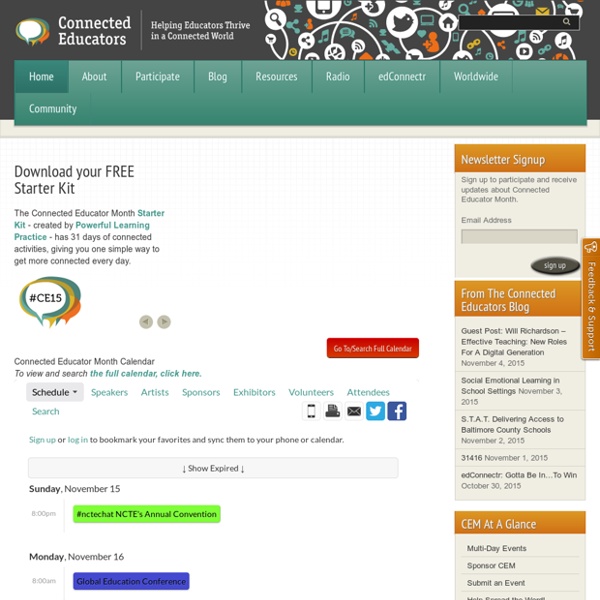



http://connectededucators.org/
The Administrators Toolkit Updated and Refreshed I originally wrote this post way back in 2009. Lots has changed since then. So let's dust it off and do some updating. Most schools and districts spend lot of time and effort trying to get their teachers up to speed on technology and its use/place in the classroom. And honestly that is where a majority of effort should be spent; working with those on the frontlines of instruction. However, rarely, if ever, is much time spent with administrators, working with them on ways they use technology to enhance what they are doing.
AJ Jacobs: The Importance of Self-Delusion in the Creative Process About this presentation How can we apply the idea of method acting to our business lives? This is the question that lifehacker and bestselling author AJ Jacobs tackles in this insightful (and highly entertaining) talk on the benefits of faking it until you make it. Through a series of examples from his own life, Jacobs shows just how much our behavior shapes our thoughts and our perceptions. Thus, if we want to change our attitude about something, the best way is to “act as if.” About AJ Jacobs
MindShift MindShift explores the future of learning in all its dimensions. We examine how learning is being impacted by technology, discoveries about how the brain works, poverty and inequities, social and emotional practices, assessments, digital games, design thinking and music, among many other topics. We look at how learning is evolving in the classroom and beyond.We also revisit old ideas that have come full circle in the era of the over scheduled child, such as unschooling, tinkering, playing in the woods, mindfulness, inquiry-based learning and student motivation. We report on shifts in how educators practice their craft as they apply innovative ideas to help students learn, while meeting the rigorous demands of their standards and curriculum. MindShift has a unique audience of educators, tinkerers, policy makers and life-long learners who engage in meaningful dialogue with one another on our sites.
How to connect the dots SmartBlogs One of the biggest things I have learned in the past two years is that I don’t need to know the answer; I need only to know how to get the answer or point somebody to the answer. It’s a skill that I have developed since becoming a connected educator. Becoming a connected educator has helped me grow more than I could have imagined, and it’s allowed me to help educators in my district and far beyond. When I am faced with question, whether my own or somebody else’s, I go through several resources that help me connect the dots. This is no certain order. 1. faq.essaytagger.com The only other limitation is that iOS devices (iPad, iPhone) do not support Flash and therefore the grading app will not function on iOS. An internet connection is required. How do I get my students' papers into the system? Teacher batch uploads: The most basic method is to have teachers upload the essays themselves. This places the burden on the teacher, but makes sense for those teachers who have a "hand-in" folder on the school network or who receive their assignments via email. Students upload to an assignment link: No logins are required.
What Real Collaboration Between Teachers and Techies Looks Like This is what edtech should be: teachers, administrators, and even students, and edupreneurs participating in the same conversation. On Thursday, July 11, hundreds of teachers and administrators from public, private and charter schools from the Chicago region spent a day of their free time learning more about the 30 edtech startups and trying out their products. The beautiful, light-filled Harold Washington Library, imbued with a long history of spreading knowledge for all, provided the perfect backdrop for these lively interactions. Nets Standards Education technology standards to transform learning and teaching The time for major change in education is now. In a world where rapid advances in technology have a profound impact on the ways we work, communicate and live, education has struggled to keep pace. The ISTE Standards work together to support educators, students and leaders with clear guidelines for the skills and knowledge necessary to move away from the factory model. These are not the typical boxes educators need to check. They provide a framework for rethinking education, adapting to a constantly changing technological landscape and preparing students to enter an increasingly global economy.
6 Characteristics Of Tomorrow's Classroom Technology Predicting the growth of technology is impossible–in both rate and direction. The same likely applies to learning. Combine them and you’ve got even greater uncertainty, but that’s what Michell Zappa and the folks over at Envisioningtech.com did in creating the following massive concept map. In the visual there are three distinct domains/learning spaces: Classroom, Studio, and Virtual. Within these domains are 6 sub-domains that represent both areas of growth and characteristics of how learning might change when fused with emerging technologies. 1. The 7 Habits Of Effective Connected Educators Are you integrating technology or hoping to become a more effective teacher? If you circled one or both of those options, then listen up. Also, go grab a damp towel before that marker stays permanent on your computer monitor! Okay, all cleaned off? Let’s learn about some of the must-know habits of effective connected educators.